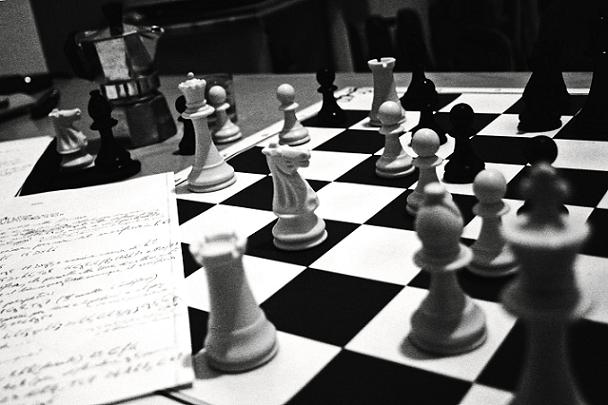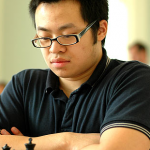Chess Corner: The original beautiful game
Chess Corner, Features - Posted on Thursday, September 23, 2010 23:00 - 2 Comments
 By Paul Lam
By Paul Lam
Greetings dear reader! It is an honour to introduce the first of my bi-weekly chess columns in ‘Ceasefire’. If you would forgive the indulgence, I’ll start my tenure with a few words about myself. I started playing chess relatively late in life, at the ancient age of eleven. Today, this is an age at which some players will have already attained the master title.
However, I went on to make quick progress, representing England at under-14 and under-18 levels. Nowadays, I largely restrict myself to local league chess, occasionally playing in an international tournament, the most recent being the 2008 EU Championship where I performed creditably, achieving a draw with leading Swedish Grandmaster Tiger Hillarp Persson and finishing the tournament with a master-strength rating performance.
I continue to involve myself in the game in alternative ways, through coaching for example, while maintaining contact with chess-friends, and keenly following events in the chess world. This column will, I hope, be a great opportunity for me to cast some light upon a game that is sadly neglected today in the UK by the published media. While I am quietly confident that chess-players will enjoy this column, it is also my hope that it will prove accessible and of interest to non-chess aficionados too.
Chess may seem like an absurd delight to the outside observer at times. A huge amount of time and effort is invested for little tangible reward. It is sometimes remarked that the best chess player in the tournament hall is often the worst dressed. The fact that a place in the chess world’s top 100 is no guarantee of financial stability speaks volumes, particularly if we compare it to popular sports such as tennis for example.
It is regarded as a truism that the pain of losing in chess is far greater than the joy of winning. The feelings of intellectual inferiority and intense self-disgust after a loss are far from extreme reactions; every chess player will be able to testify to them. Perhaps it is this that inspired George Bernard Shaw to dismiss the game as a foolish expedient for making idle people believe they are doing something very clever when they are only wasting their time.
However, I hope to show in this column that chess is not merely a form of mental masturbation, and not a mere game either. The layman marvels at the memory feats of chess-masters, the ability to play dozens of games blindfolded, simultaneously, and win most or all of them, the lightning speed at which one can calculate ten moves ahead, as well as assimilate, analyse and evaluate, in complex positions*.
These are undoubtedly impressive achievements. However, I suspect that the layman struggles to comprehend the aesthetic value in chess. Exclamations of ‘that was a beautiful move!’ or ‘what a beautiful position!’ by chess players engrossed in their activity are met only by puzzlement on his/her part. The wonder of chess, however, is that the more one learns and understands it, correspondingly, the more beautiful the game becomes.
Indeed, all players are usually able to relate back to a familiar scenario we’ve all had to witness or face in our chess infancy-a stage in which materialistic thought dominates- in which we looked on in horror as a player gave up his queen, the most powerful piece on the board, only to look back in amazement when he then delivers a checkmate in the next move.
The concept of the sacrifice in chess is a very basic one in essence (although it can manifest itself in far more complex forms), yet it still causes delight and pleasure in even the most accomplished of players. But there is an even higher level of aesthetic value: what I like to call ‘seeing beauty in ugliness’, a moment of ‘chessic’ epiphany in which hitherto unsightly moves are suddenly transformed into gems and we realise that they were only ever ostensibly ugly because, due to their profundity, we had previously failed to understand their true meaning. For me, this represents the true beauty of chess.
Many non-chess players also often mistakenly think of chess as a purely rational game. This is an oversimplification that neglects the multi-faceted nature of the game. Chess is simultaneously science and art, abstract and material, calculation and imagination. Additionally, the role that intuition plays in chess cannot be overstated. Furthermore, chess is not just about playing positions but also about playing people. There is therefore also an element of psychological warfare to the game. Chess is not a static game either, but constantly evolving. Novelties in opening theory are discovered monthly, positional understanding is continuously developing, and barriers are consistently being broken at the highest level. The richness and abundance of tactics and strategies to be found in chess are unrivalled by other games of perfect information.
Because of the game’s unparalleled complexity and because you are always learning something new, it represents a personal challenge; an inspiration to strive for self-betterment. Speaking from personal experience, I can confidently say that playing chess has been indispensable in honing transferable skills such as logical thinking, the ability to concentrate and remain focused for long periods, and resilience under pressure, all of which have had immense benefits for me off the chessboard.
I hope this column will prove thought-provoking and entertaining in equal measure; a constructive source not only of chess wisdom, through the presentation of games, analysis and problems, but of political/social/cultural commentary on matters relevant to chess and the chess world.
I wish to move beyond pervasive stereotypes to show the uninitiated that chess is not just a game and not simply a battle between two egos, but symbolises everything that makes us human. For readers who aspire to improve their chess playing, I hope that they will be able to gain advice from this column that will prove helpful to them both on and off the board, and remember: hard work and a desire to learn will take you a long way.
Finally, it is my sincere hope that every reader will approach the column every fortnight bearing the same feelings that I often experience before a game of chess; a combination of excitement and anticipation. I look forward to your feedback!
 Paul Lam, a law graduate, is an internationally rated chess-player. He was one of England’s leading junior players, representing the national team in Estonia and the Czech Republic. His column on chess will be appearing every other Thursday
Paul Lam, a law graduate, is an internationally rated chess-player. He was one of England’s leading junior players, representing the national team in Estonia and the Czech Republic. His column on chess will be appearing every other Thursday
2 Comments
Alex
Corin Faife
I second the above – reading this has made me want to reach for my board right now! Looking forward to picking up some tips and insight from future instalments.


Lovely column! Looking forward to another installment.